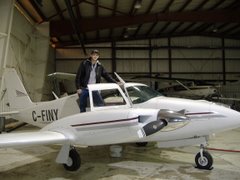Despite the heavily populated countryside our survey lines still dictate that we just plow right over top of any local airports in our survey block at the usual 200 ft. The less times we have to break line and go around things the better our data is. Unfortunately overflying airports at 200 ft can provide for some unique safety issues if the airport does have local traffic flying around, so its important to keep in radio contact and keep other traffic informed, as well as have both sets of eyes scanning for traffic.
The Navajo is also equipped with a Zaon PCAS (Portable Collision Avoidance System) unit, and it got a pretty full workout today. I have to say I'm impressed with it. I've seen them before in Aviation shops before but never got to use them, but have always been intrigued by the idea but have been a little skeptical. But I can honestly say this thing is an excellent piece of gear for what you would pay for it.
As far as air-to-air collision avoidance systems go, there a few different levels, all with a different levels of features, and different levels with which they will drain your bank account.
All of these systems are dependent on potential conflict aircraft being equipped with a functioning transponder that will send out return signals after it receives an "interrogation" signal from either a ground radar site, or a special type of transponder (Mode S) from another aircraft. If the other airplane that is about to cross your path doesn't have a transponder, or its not turned on, no system is going to see it - unless of course you're flying a military jet that's equipped with air-to-air radar. The good news is that the vast majority of airplanes do have transponders.
A PCAS system like the one we have in the airplane is entirely passive. It doesn't have the ability to send out its own interrogation signals, but merely listens for the reply signals of other airplanes, and it can plot their position relative to itself that way. Like I said I'm quite surprised how well it works. The major disadvantage to it being passive however is that it is depending on ground radar stations or third party Mode S equipped aircraft to send an interrogation signal and trigger the target aircraft's transponder reply. That means that PCAS is basically useless up north where there is no ground radar coverage. If an aircraft doesn't have its transponder triggered, the PCAS can't see it. For use in medium to high density airspace however, where there most likely is ground radar coverage that can trigger transponders, it has been excellent. The model we have does give relative direction, distance, and altitude with reasonable accuracy. And I've been able to visually spot targets in about the same amount of time it takes me to find traffic when its vocally pointed out by ATC for me.
We happened to buzz by a para-glider who was floating around in the updrafts of some hills, and the PCAS didn't pick him up (no transponder) but his big parachute was easy to spot nonetheless. We probably scared the pants off of him though, haha.




No comments:
Post a Comment